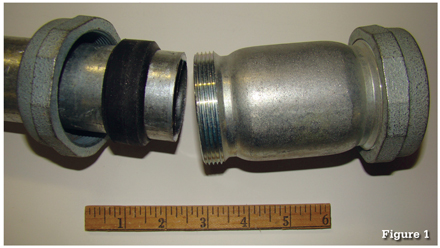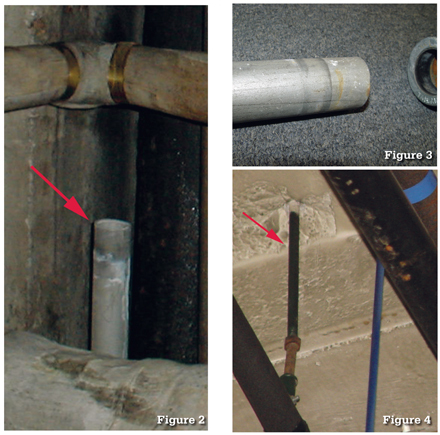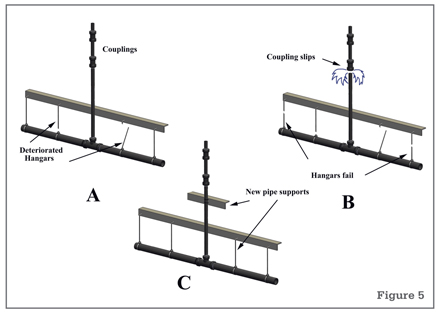 Great care should be exercised when installing compressioncouplings, as installation errors can cause pipe failure resultingin expensive property claims.
Great care should be exercised when installing compressioncouplings, as installation errors can cause pipe failure resultingin expensive property claims.
Figure 1 to the right is a view of a typicalplumbing compression fitting used to splice plumbing pipes. In someinstallations with long pipes and limited access, replacement of asection of pipe is accomplished with two compression couplings ateach end of the replacement pipe.
|The following case study illustrates the importance of preciseinstallation. Plumbers repaired a pipe that was leaking, as aresult of corrosion, on the third floor in an old historicbuilding.
|Click “next” to the right for the full details.
|They removed a section of the pipe and replaced it along withtwo compression couplings, one at each end. The plumbers finishedthe work and left. Approximately three days later, one of thecompression fittings parted, causing a significant waterloss.
|The arrow in Figure 2 (to the left below) showsthe pipe that had parted from the compression fitting, whileFigure 3 depicts the parted pipe and the outlineof the compressed rubber seal of the compression fitting. Thecompression fitting worked its way off the end of the pipe,allowing water to pour down several floors of the building.
|Further inspection of the vertical pipe in the basement yields aclue as to the cause of the coupling failure (shown inFigure 4). The vertical pipe that pulled loose ofthe coupling (as highlighted by the arrow in Figure4) terminated at a T fitting with a largerpipe.
|The hangars of the larger pipe had deteriorated, therebyrendering the large pipe virtually unsupported other than thesupport of the vertical pipe that failed. The friction of thevertical pipe through the concrete floors and the deteriorated pipehangars were the sole restraint holding the large horizontal pipein place.
|
 Figure 5 to the right illustrates thefailure scenario.
Figure 5 to the right illustrates thefailure scenario.
Figure 5A shows the system with the coupling inplace, shortly after the plumbers had left the job site.
|Figure 5B shows that the vertical load-carryingcapacity of the pipe has been significantly reduced with the usageof the compression fitting.
|Because of the limited axial-force capacity of the vertical pipewhen using compression fittings, the deteriorated hangars failed,shifting the load to the vertical pipe and couplings. The couplingscould not support the load, and then slipped andparted.
|It should be noted that compression fittings require restraintsagainst axial movement brought on by weight and vibration-relatedforces. Unlike threaded fittings, compression fittings can sealproperly but nevertheless slip out of position as a result offorces on a pipe. In this case, the plumbers failed to properlyrestrain the repaired pipe when using compressionfittings.
|Figure 5C shows that a restraint for thevertical pipe and hangar repair should have been performed beforejob completion. A quick inspection of the pipe in the basementwould have revealed the necessity to repair the pipe hangars andrestrain the repaired pipe. No defects were noted in thecompression fittings that could have caused the failure. Analysisof the evidence suggests that the underlying cause of the failurewas improper repair of a water pipe.
Want to continue reading?
Become a Free PropertyCasualty360 Digital Reader
Your access to unlimited PropertyCasualty360 content isn’t changing.
Once you are an ALM digital member, you’ll receive:
- All PropertyCasualty360.com news coverage, best practices, and in-depth analysis.
- Educational webcasts, resources from industry leaders, and informative newsletters.
- Other award-winning websites including BenefitsPRO.com and ThinkAdvisor.com.
Already have an account? Sign In
© 2024 ALM Global, LLC, All Rights Reserved. Request academic re-use from www.copyright.com. All other uses, submit a request to [email protected]. For more information visit Asset & Logo Licensing.








